
Normal stars, like our Sun, produce some X-rays in their outer atmosphere. The gas in this regions, known as the Chromosphere, is very hot and tenuous. Flares and prominences on the surface of the Sun also produce X-rays as a result of reconnection of magnetic fields. Although in the "History of X-ray Astronomy" it was stated that X-rays from other stars could not be observed, this was true for the 1960's, and today stars are observed with X-ray telescopes. Their X-ray emission does vary and this is a field of study. However they do not emit many X-rays in comparison with the emission associated with Black Holes and Clusters of Galaxies.
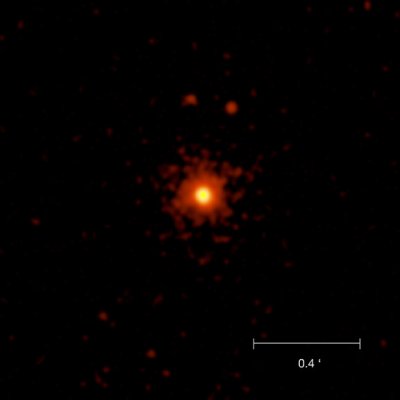 |
| An X-ray image of the closest star, Proxima Centauri. This shows that X-ray images from nearby stars on the whole tell us little, spectra on the other hand can tell us more. (Image courtesy CHANDRA) |
These are early type stars - O and Wolf-Rayet types. They have large mass loss rates in the form of a large wind, much stronger than the solar wind. The shocks in the wind heat the plasma which then emits X-rays. Observations spread out in time of these stars has allows researchers to show that sometimes the wind is confined to a plane by a magnetic field, as the X-ray characteristics are different in the different observations.
Some of these stars are in binary systems, and then one of the pair will have a less strong wind. The collision of the two winds causes a steady shock wave. The X-rays from this wind can irradiate the other star. If the binary is eclipsing, then the variation of the signal as the stars orbit one another can determine the exact geometry of the system.
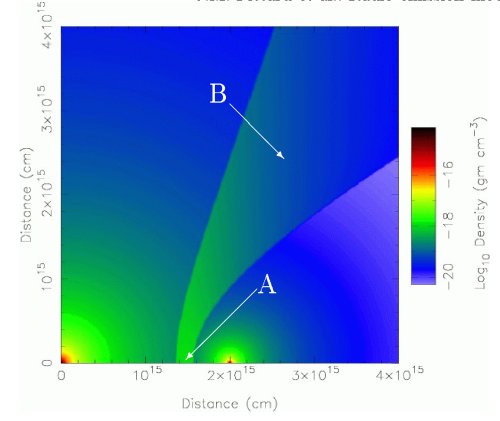 |
| A model showing the interaction of the winds from two stars in a binary system. A is the stagnation point and B is in the shocked gas. (Image courtesy J.M. Pittard, Astronomy & Astrophysics) |
Normal stars like our Sun fuse Hydrogen to Helium in their cores, releasing energy that we see as light and heat. When they run out of Hydrogen, the core contracts and heats up to then fuse Helium, and the outer layers expand and cool; it becomes a Red Giant. Eventually it has no more fuel that it can burn, and it blows off its atmosphere, which forms a Planetary Nebula, and the core remains - a White Dwarf, the cinders of a star cooling slowly.
If the star is very massive the end is much more spectacular. It can fuse elements together until it the ed product of these reactions is Iron. To fuse iron requires energy rather than releasing it, and so an iron core is built up in the star. Eventually the core looses its battle against gravity, it can no longer support itself and collapses until it is as dense as an atomic nucleus. It then rebounds and blasts the star apart in a Supernova explosion. The outer layers of the star are expelled into space and form a Supernova Remnant. What is left of the centre of the star is either a neutron star or a black hole.
The outer layers of the star travel outwards much faster the speed of sound; they are a blast or shock wave. This compresses the tenuous gas in between the stars (the Inter Stellar Medium, ISM) which causes the emission of X-rays. The remnants of these blasts are some of the most beautiful objects in the night sky. The Crab Nebula in the constellation of Taurus is what is left of a star that went supernova in 1054 and was observed by the Chinese.
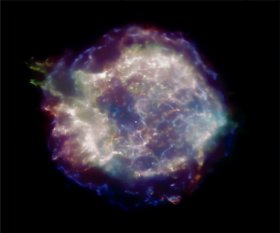 | 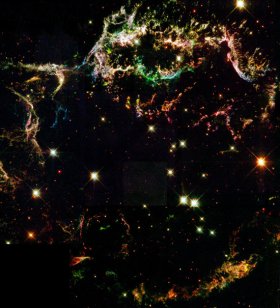 | 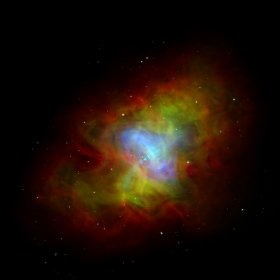 |
| Cassiopeia A Supernova remnant as seen in X-rays. The low, medium, and higher X-ray energies of the Chandra data are shown as red, green, and blue(Image courtesy CHANDRA) | Cassiopeia A Supernova remnant as seen in visible light. (Image courtesy CHANDRA) | Crab Supernova remnant - three colour image with X-ray in blue, optical in green, and radio in red. (Image courtesy CHANDRA) |
The result of the core of the star forming a black hole is covered in another section . However if the core of the star forms a Neutron Star, then this can also be a source of X-rays. Neutron Stars are compressed balls of neutrons which are held together by gravity, they are very dense, one pin-head of Neutron Star material would weigh as much as a battleship! They can have intense magnetic fields associated with them, and they can also rotate very fast (think of when an ice-skater spins and draws in their arms, the star has lost its outer layers, and so the core now spins extremely fast). As it is the naked core of the star it is initially very hot and emits X-rays; however they cool over many years. Once it has cooled down it can only be seen if the magnetic axis is not aligned to its rotation axis - like with the Earth. As the magnetic fields are so strong radiation and particles are channelled down the magnetic poles and the stars can only be "seen" when a pole points towards the Earth - this is then known as a pulsar (pulsating star) as a set of regular pulses are observed, like a lighthouse.
The X-rays that come from the central remnant of the Supernova cause the elements in the expanding gas shell to fluoresce. Different elements show up at different energies, which allows the composition of the gas shell and also the star to be estimated.
X-ray images of the Crab Nebula show the effect the pulsar has on the central regions. Spinning motions and jet-like features can be seen in the CHANDRA X-ray (Blue) and Hubble optical (Red) images.
Crab Pulsar Movie - .mov
Crab Pulsar Movie - .mpg
Movies courtesy NASA - CHANDRA.
BACK: All Sky Surveys UP: X-ray Research Topics NEXT: X-ray Binaries